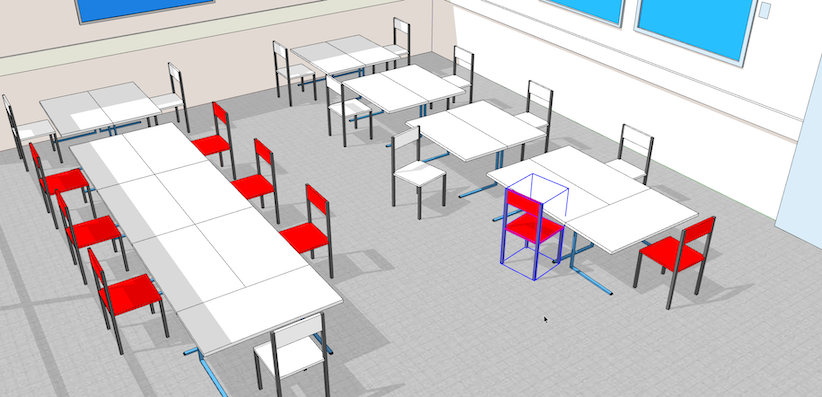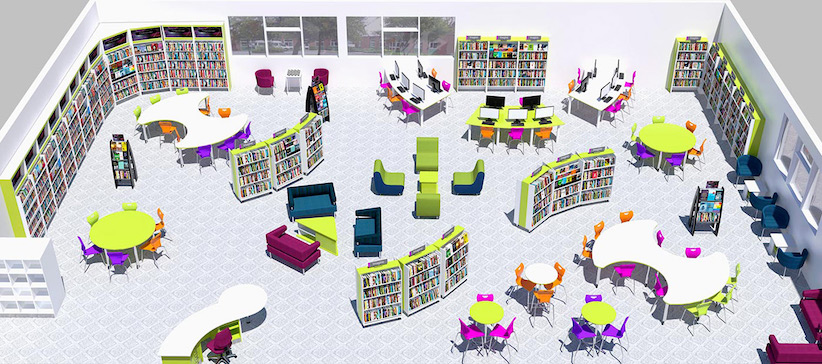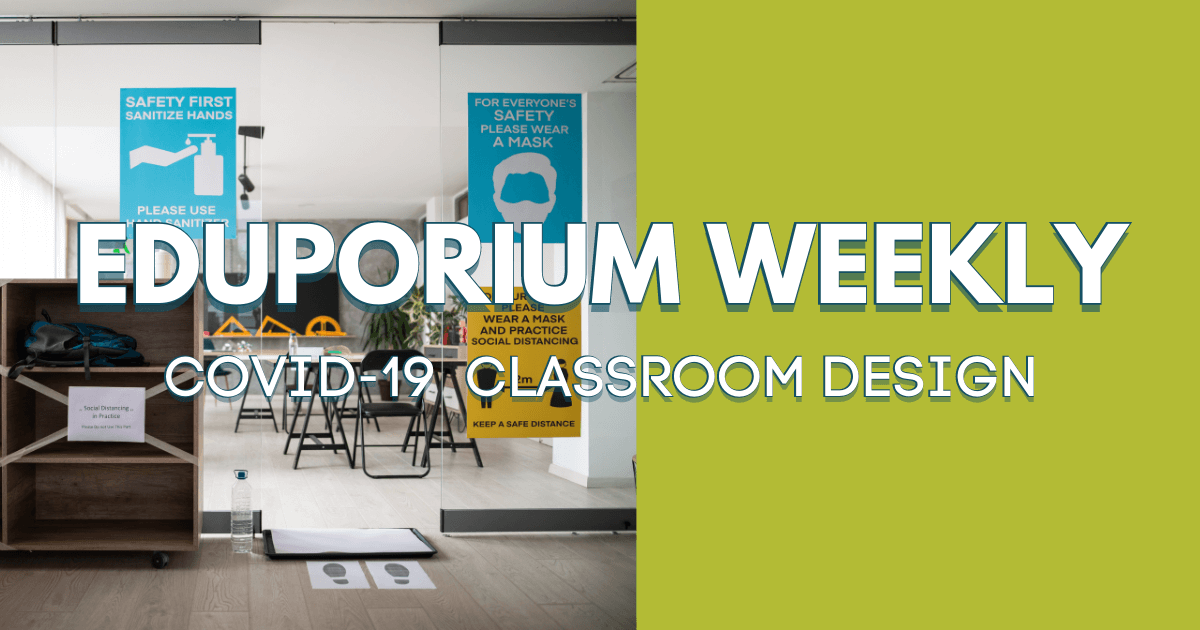For school leaders who determined that they wanted to do everything they could to ensure students could return to the classroom this fall, their planning began long ago. In schools in many parts of the country, the protocols put into place to help stem the spread of the coronavirus while providing students with in-person learning opportunities have been successful, but, in other places, they have not. As we all know, the plans within some schools and districts have changed and students who began the year in the classroom either full-time or partially have reverted back to distance learning. But, this week, we’re talking about what the classrooms look like in the COVID-19 age. We're also sharing some tips for classroom design whether all students are there, some are there, or teachers are alone.
Rethinking Classroom Design With Modern Restrictions
When it comes to classroom designs for in-person learning, educators are essentially using every inch and every piece of technology. The goal of classroom design these days should see student and teacher safety at the top of the list and, on top of that, help ensure everybody feels like they are safe too. If educators and students are spending much of the school day worrying how safe they really are, then they’re probably not placing enough of a focus on teaching and learning effectively. Of course, the biggest change for students since returning to school is the effort to allow for physical distancing. There are likely markers and signs all throughout school hallways and other reminders of the world in which we now live, like trash bags over the drinking fountains, duct tape over every other cafeteria seat, and hand sanitizer always within reach.
By ensuring safety with physical restrictions in place, the main drawback is there might not be room for all students. You don’t realize how small classrooms actually are until you try to successfully place 25 children within it and also keep all of them six feet from each other. This has led some teachers to suggest limits on class sizes, which may sound promising in theory since there have definitely been some kids who've opted to stay home. Even with desks spread out, teachers and students are still doing a lot of cleaning during the school day to give everybody the best chance of not contracting any dangerous germs. It’s not uncommon for students to be wiping desks and to not be facing any of their classmates while seated. Keeping space between kids and making sure they’re not sitting face-to-face are key elements of today's classrooms.
School leaders have also had to think about what educators should do to maximize safety for all. This has included trying models in which all students stay in the same classroom each day and teachers of different subjects come to them to minimize traffic and potential spreads. Other safety measures include using only desks and tables with smooth and easy-to-clean surfaces so that disinfecting becomes more effective and installing clear shields around as many desks as possible—something that adds an entire other element of isolation to today’s classrooms. Keeping classroom spaces flexible and utilizing outdoor learning or bigger rooms, like gyms or libraries, can also maximize safety. In almost all in-person learning, school leaders will need to make adjustments and learn from what they've tried. They might also break from traditional norms while knowing that even the greatest preparations can fail at any time.

Desk Setup Ideas to Keep Students Safe
If overcrowded classrooms were already a big concern among members of your school’s community, they probably remain so now. Of course, everyone wants increased space between students and teachers also to allow for safe physical distancing in in-person learning. Typical class sizes across all levels of education, however, could range from 20-30 students on the high end and that already presented space issues when it came to seating everybody comfortably. To maximize safety, it seems like the maximum number for kids in any classroom should be around 18 or 20. With some students staying home, this is possible, but, most likely, teachers have another problem to solve—keeping everybody apart. This is challenging enough with older students, but, as we’ve seen, almost impossible with the youngest.
Some ideas have been suggested and implemented to make these schooling experiences as effective as possible despite distance between students. It could be small groups of desks, a circular setup, or perhaps staggered desks throughout your room to keep children from directly facing each other, but none seem like a clear winner. The team pods idea could involve plexiglass shields if educators have them available (if they do, they probably bought them themselves), though they'd also need them installed. Depending on the size of your classroom space, grouping two, three, or four desks together could be possible. Students would be facing each other but would presumably be far enough apart (in the shape of a ‘plus’ sign). This could keep them safe and, as we’ve seen, we can also assume they’d be wearing face coverings as well.
The circular option would allow teachers utilize the periphery of the classroom and still leave enough space between student desks. With more space then available in the center of the room, some more desks could potentially fit, too. If there are no desks in the center, however, there probably wouldn't be enough room for the typical number of students in a K-12 class. Finally, clustering desks at the minimum distance apart may allow for the highest number of students to fit safely in each classroom or the other option to keep desks in traditional rows (with a few extra desks placed wherever there is space) might make the most sense in your situation. In the cluster option, your could strategically place dividers (and clean them each day) to provide barriers if needed. Teachers can then use mobile whiteboards or other classroom objects if possible.
Redesigning the Media Center for Student Safety
We're really focused on classroom design and student safety and rightfully so since they're inside the same classroom all day. Reading and discovery are still a big part of education, however, and that means that the school libraries or media centers need safe set-ups like your classrooms. Hopefully, not every media center will need repurposing as a temporary classroom and, if learning in there can continue as normal, these few suggestions can keep everyone more safe. The first thing to do is to optimize the space for everyone’s new favorite term—social distancing. Setting clear distancing rules is key and creating enough physical space is still challenging. Librarians could look to remove extra shelving units, move books into less utilized areas of the school (hallways, closets, bathrooms) or possibly even donate ones that aren’t typically popular.
Next, librarians can devise up a system to organize foot traffic for a safer shared environment. Identifying where students should enter and exit the library and establishing a clear traffic flow are good areas to start. Placing markings on their floor is great if librarians can do so. This helps to clear up some social distancing challenges presented by the current pandemic. As for bookshelves, realigning them will create more space if they'd have always been in rows, which is common. To promote social distancing, bookshelves could sit on the outer walls of the library to create more space in the middle (much like the ‘desks in a circle’ option we discussed earlier). You may not be able to fit them all on the edges of the library but that's okay. Social distancing will be easier with more room in the center of the school library.
If the option is available, flexible furniture in the media center can definitely come in handy during this time. This includes mobile desks, chairs, and furniture like bean bags instead of large tables and desks attached to chairs. This flexible furniture allows for easy repositioning and for all students to space out while using it. Finally, you could also create personal spaces for children in the media center like in the classroom. Setting up dividers helps and spacing out student desks or individual reading tables would be good. Librarians can even remove every other chair from larger tables, which is happening in school cafeterias. Then, they could set limits of how many people are in the library at once—hopefully creating more organized safety.

Other Tips to Keep the Classroom Safe
You likely have a routine in place by now if you’ve managed to stay with in-person learning this deep into the school year, but sharing a few more tips we’ve heard from educators probably won’t hurt. In this next section, we'll focus more on some strategies teachers can use to keep kids in their own space. This starts with the design aspects and creating a space for every student to be physically distant from everyone else as much as possible (which we’ve already talked about plenty). Additional safety strategies include getting students used to using only their individual supplies, like pencils, scissors, and paper. Especially with your younger kids, they’ll like having their own personal school supplies and they'll also learn organization and responsibility. It's an opportunity to reinforce that, these days, it’s not always best for them to be sharing.
Besides being further apart, another aspect of ‘new’ classrooms is fewer physical shows of appreciation, like hugs and high fives. This has led to some teachers establishing a new take on their signs of affection, particularly with using sign language. Not only does this provide a wonderful opportunity to teach children something new, they can then use the signs they learn to communicate with friends in a different way. Also, should in-person learning ever change to hybrid or remote learning, kids could communicate with teachers and classmates while muted. And, since we are talking about communication, we might as well involve the SEL side of things, too. Helping students maintain a positive mindset will remain important as will helping them manage their emotions. Making sure kids are comfortable with sharing their fears or apprehensions can help and so can helping them find positivity.
Along these lines, educators have found some additional ways for kids to high five using a bit of MakerEd. Students can use cardboard and any other art supplies to build high-five extenders for slapping hands with friends without touching. All you need is some construction paper, tape or glue, markers, and a yardstick or long thin piece of cardboard. Also, taking students outside could offer a boost to them in a lot of emotional ways. The Sun could help them feel better, the fresh air could help them feel safer, and, if they do not have to wear a mask, they may feel more connected for a little while. That could also allow the teachers to work more (physically) closely with children who need extra instruction and emotional supports. Plus, if nothing else, it just helps break up what has likely become a stressful situation for everybody by now.
The Effects of Remote Learning on Classroom Design
In some schools and even colleges, learning has returned to the classroom albeit for an uncertain amount of time. Obviously, this isn't true everywhere, but those who are back into classrooms are providing others with insights for the future. Since almost every class (if not every one) was remote during the spring, pretty much every student and educator took part in remote learning for at least a couple of months. In that time, everyone learned a lot about what works and what does not work in delivering instruction, what might have potential depending on the ages of students, and some of the technologies that can help. As the education world shifts, distance learning might become fairly common in non-emergency circumstances. So, some of what we learned in this period can affect how classrooms are designed going forward.
Teachers have adapted in countless ways since the onset of remote instruction and, as seen, classroom design is indirectly involved. Feedback from students and parents has led to many teachers adapting their styles. They're also tweaking a lot of the little things they do as well as the environments within which they teach. One specific thing that classrooms may end up being redesigned to incorporate is better acoustics. Teachers have discovered how important good acoustics are when delivering instruction remotely and, as time goes on, it’s more likely that kids will be split among those learning in-person and those still at home. This means students at home must be able to hear teachers clearly and hear any points from classmates.
Another way the classroom may change is with the presence of an always-on camera. This will, of course, allow remote students to access lessons. But, it also enables educators to record and potentially distribute everything so students can rewatch anything they need clarity on. It would also allow for students to watch lessons after the fact if they’re sick or have a technical issue. Finally, while more educators experiment with classroom designs in this era of learning, they’re going to be sharing their findings. Teachers will be able to recommend design strategies, camera options, online platforms, and tips for engaging students in multiple locations. As of now and for the foreseeable future, there are tons of moving parts and no perfect solutions. With more time, however, it could be easier to figure out what works and maximize the classroom space.
For the latest EdTech, STEM, and 21st century education news, follow us on Twitter and Instagram. Like us on Facebook, too, or sign up for our newsletter for our latest product announcements and offerings. If you have an idea for an Eduporium Weekly theme, send us a message on social media or comment below.



